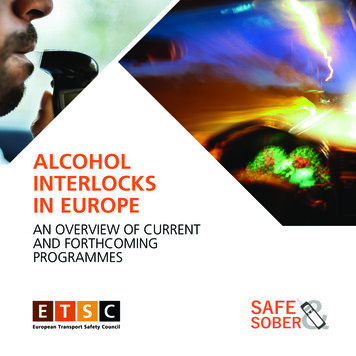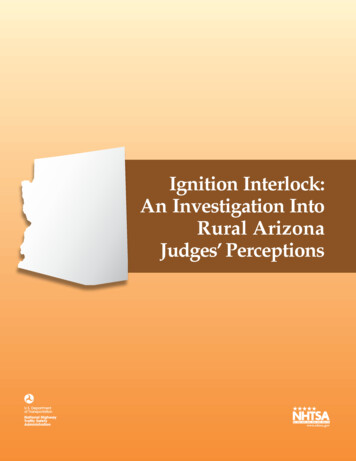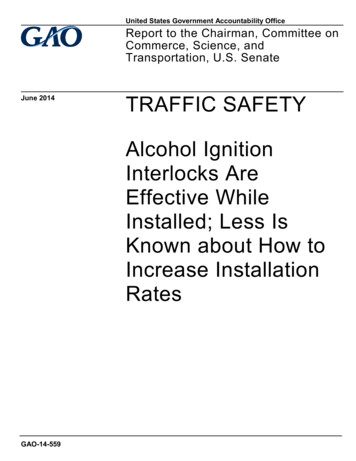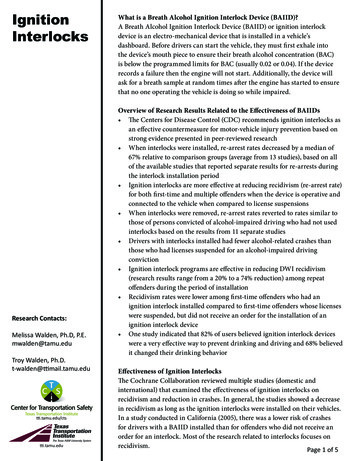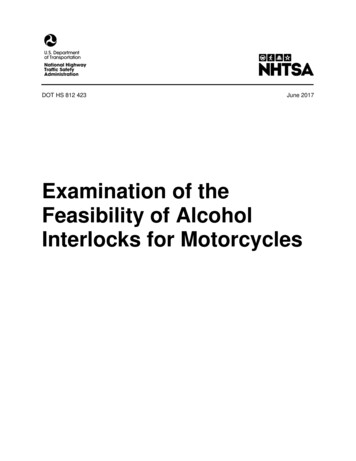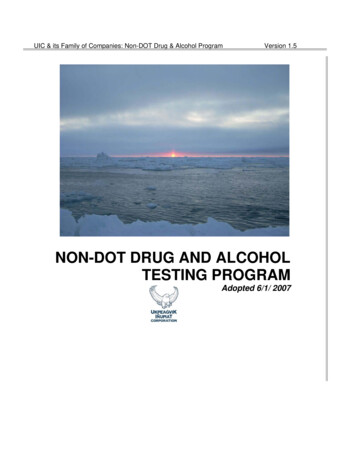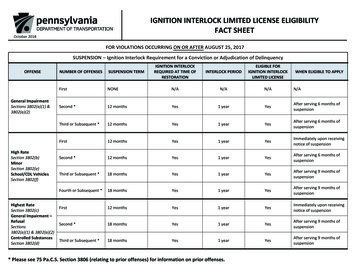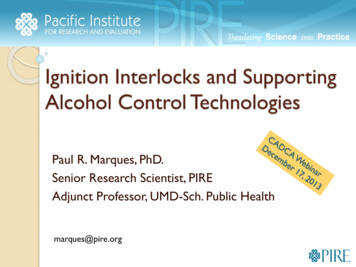
Transcription
Ignition Interlocks and SupportingAlcohol Control TechnologiesPaul R. Marques, PhD.Senior Research Scientist, PIREAdjunct Professor, UMD-Sch. Public Healthmarques@pire.org
Webinar Topics Basic Interlock OperationInterlock installation Rates over TimeRecidivism During InterlockRecidivism After InterlockCan Interlocks Solve the DUI Problem?First Offenders - Interlock?USA Interlock Program TypesStories told by the BAC Test Log FileAlcohol Biomarkers and Interlock
Interlock Basics
Basic Features of an InterlockAn alcohol sensor that detects BAC .02 and prevents vehicle startups A running retest feature that requiresperiodic retesting while underway A tamper detection installation thatdetects efforts to alter the wiring A data-recording function that logs allactivity: BAC results, stops, starts, refusals Anti-circumvention protocols
Important Distinction Interlock Devices – the hardware– Early devices were non-specific (Taguchisemiconductors – their calibration would driftand react to many hydrocarbons); today mostsensors are alcohol specific fuel-cell devices. Interlock Programs – the procedures– Laws (court or licensing programs), sanctions,regulations, reporting protocols, informationflow, treatment links, consequences; the ways inwhich the devices are used.
Our (PIRE) interlock work (Marques,Voas,Tippetts): 6 Themes, 25 yearspolicy-relevant guidelines and research,(2) studies of interlock ability to control DUIrecidivism,(3) the capabilities of the interlock BAC failrecords to predict future DUI,(4) impact of a motivational, or other adjuncttreatment services to interlock programs,(5) the relationship of interlock BAC data, andalcohol biomarker prediction of recidivism.(6) the impact of State interlock laws onoutcomes(1)
Installation Rates
Interlock Installation Rates - USA
0New MexicoArizonaWashingtonColoradoIowaMarylandNorth CarolinaWest w YorkDelawareKentuckyNew JerseySouth DakotaNew HampshireIndianaTennesseeMississippiMinnesotaSouth CarolinaRhode IslandVermontNorth DakotaAlabamaHawaiiDCMaineDick Roth chart 2009 –2013 NM is 60, KS CO 40, AZ 33Interlocks per 10,000 residents by stateData from 9 of 10 providers; Plot by Richard Roth, PhD;August, 200945403530252015105
Interlocks Projected to 2020 withEst. DUI Convictions (green)1,400,000Number of Interlocks1,200,0001,000,000800,000R² 0.9967600,000400,000200,0000Year
Interlock Pros and Cons (briefly)
Why interlocks are endorsed10 studies 1990 - 2007140%Non-interlock control groups for each study set to 100%120%100%80%60%40%20%0%1 OH2 OR3 NC4 AB5 WV6 MDDuring Interlock7 AB8 QC9 IL10 NM
Why we are not satisfied140%Black line is non-interlock control groups for each study120%100%80%60%40%20%0%1 OH2 OR3 NC4 AB5 WV 6 MDDuring Interlock7 AB8 QCAfter Interlock9 IL10 NM
The Details Bar pair # 7 – Alberta Interlock
Interlocks – what we know These programs do reliably reducerecidivism while installed ( 65%)They do not lead to much carry-over oncelicenses are reinstatedThe most successful programs get only 50%enrollment (of all DUI convictions)For these (and other) reasons they cannotbe a total solutionWhat they do, they do wellThere is reason to believe they will have ageneral deterrence effect
Alcohol Action and DUI Arrests
How select a club are DUIs?What is the chance of arrestingan impaired driver? One in (Values rounded)25085Self-reportStudy, Liu?300Beitel et al, 1975600110017002000Hingson et al. , 1995Voas and Hause, 1987Miller, Spicer, Levy, 1999Borkenstein et al., 1974
Let’s be conservative on this One in 300 impaired operators arearrested (Voas and Hause)undetecteddetectedEstimated detectionrate of impaireddrivers with BAC .10in a high enforcementzone (Stockton, CA)*
Idealized BAC curves for Male2-7 hours expected time to alcohol clearanceafter 1- 4 drinks in an average size maleBAC Equivalences80 mg% 80 mg/100 ml.08 g/dL .8 g/L .08 % (near equiv.)
Is it fair to impose interlocks onfirst offenders?It is true that first offenders aresomewhat less risky than multiple DUIoffenders. As we showed earlier – the chance ofdetecting any impaired driver is veryremote – maybe 1 in 300 or more How do arrest BAC’s differ? How different are first offenders fromNON-offenders? What are States doing?
BAC distribution: Arrested DrunkDrivers in NM – average is .14Data from Dick Roth
First Offenders Pose Much HigherRisk than Non-OffendersPercent Re-Arrested for DWI Within Three Years vs PriorsNew Mexico2003 - 2006 (% new DUI)For Those Convicted of DWI in NM in 2003based on 2003 statusMaryland (alcohol charges)per 1000 drivers6020%5015%10%3010%5%205%0%7x higher4015%20%5x higher100DUI % repeated by 2006% Re-arrested within 3 Years25%0None11st22nd33rd44thin 2003ConvictionDUI countinNumber2003Dick Roth et al., Impact DWI, NM5th 500123Prior DUIBill Rauch et al, Westat, MD
Interlock Programs around the US
Administrative Programs Some ADVANTAGESCentralized: authority, criteria, monitoringCan be prompt installation after arrestAllows some offenders to drive legally whilemonitoredApplicable to all arrested DWI offenders. Some DISADVANTAGESLarge self-selection componentAvoided by those who need it mostMore Administrative Appeal Hearings
Judicial ProgramsSome ADVANTAGES Can be made mandatory (electronicmonitoring, jail are motivating alternatives) It eliminates self-selection It has the potential to get more interlocksinstalled per DUI. (e.g., 60% of thosearrested in NM, 62% of convictions inHancock County, IN.)Some DISADVANTAGES Judges often do not apply their laws Overburdened probation departments mustmonitor, personnel spread too thin Installation not immediately after arrest. Your honor, I don’t own a car! And I have no intention to drive!
The next six slides are from IIHS’Eric Williams’ presentation in May2013 at the Association of IgnitionInterlock Program AdministratorsThe IIHS (Insurance Institute forHighway Safety) is a highly regardedsafety research center in Virginia.
Optional alcohol ignition interlock lawsApril Judicial discretion onlyrepeat offendersFLAKhigh-BAC first offendershigh-BAC first & repeat offendersall offendersHIData/slide from Insurance Institute for Highway Safety IIHS
Laws mandating alcohol ignition interlock ordersApril Judicial discretion onlyrepeat offendersFLAKhigh-BAC first offendershigh-BAC first & repeat offendersall offendersHIData/slide from Insurance Institute for Highway Safety IIHS
Laws mandating alcohol ignition interlock ordersApril Judicial discretion onlyrepeat offendersFLAKhigh-BAC first offendershigh-BAC first & repeat offendersall offendersHIData/slide from Insurance Institute for Highway Safety IIHS
Laws mandating alcohol ignition interlock ordersApril Judicial discretion onlyrepeat offendersFLAKhigh-BAC first offendershigh-BAC first & repeat offendersall offendersHIData/slide from Insurance Institute for Highway Safety IIHS
Laws mandating alcohol ignition interlock ordersApril Judicial discretion onlyrepeat offendersFLAKhigh-BAC first offendershigh-BAC first & repeat offendersall offendersHIData/slide from Insurance Institute for Highway Safety IIHS
Laws mandating alcohol ignition interlock ordersApril Judicial discretion onlyrepeat offendersFLAKhigh-BAC first offendershigh-BAC first & repeat offendersall offendersHIData/slide from Insurance Institute for Highway Safety IIHS
Mandate Interlocks? Think for a minute: what does that mean?Mandate – meaning that unless the offenderinstalls he has to sit out his suspension periodwith no driving?Mandate – meaning without an interlock he willnever drive legally in that state again?Mandate meaning offender must obtain a car(even if he has none) and install before drivingagain?Mandate – meaning he stays in jail unless heinstalls?Also a law may “Mandate” but that does notmean it is enforced.
Interlock Log Files – the DataRecord
The Interlock Data Record What is it? BAC levels: pass/fail, time/date stamp, failure tocomply with requirements, engine on/off etc What can it tell us? Who warrants more watching? Who is using theinterlock car and when? How many BAC tests are in there? Average 7/day x 365 2550/year/driver How can we use it to improve safety? Adjust interlock requirements or monitoring toreflect performance on interlock program.
First and Repeat Offenders give 6-8BAC tests daily*Quebec BAC Tests per day1100* About half arestart up tests1000900800700600500400Frequency3002001000Std. Dev 4.63Mean 8.8N 9176.00.032.030 0.28.026 0.24.022 0.20.018.016 0.14.012 0.1008.06.04.02.00.
How many BAC tests are takenover time? (each bar is 2 months)Alberta data 2009So about 5-6 testsper day (half are starts)
BAC lockouts .04 (failure ratedecline) - 2 month intervalsAlberta data 2009
Interlocks: Fewer Fails, LessRecidivismThe preceding slide demonstrated thatthe rate of failed BAC tests declinessharply over the duration of the interlockprogram. This effect has been found in every one ofthe 10 or so studies that examined it. Combine this with evidence of reducedrecidivism during interlock. Recipe for enthusiasm.
Stories in the Data File – day of the weekInterlock BAC Tests .02 g/dLTuesday lowNewMexico11 milliontests2004-2008
More on Tuesday0.70%5.5 million testsHifail .08%0.60%Fail .10%0.00%SUN18.8 million testsQuébecMonTuesWed1.00%0.90%0.80%Hi fail .08%0.70%0.60%Low Fail .02-.039%ThursFriSATMid Fail diMardiMercrediJeudiVendrediSAMEDHI
USA 2007: Fatal Crashes with DriverBAC .08 by day of week; N 9884Tuesday low
More stories in the Data File – hr of dayAlberta 1994-98 (fail .04%)Interlock FailsInterlock FailsWorkday (Monday-Friday)Weekend (Saturday-Sunday)3005007-8 am high10-12 high400200300200100gm/dlgm/dlCountCount100.008 .080 0.040-.0790246810 noon 141618200.040-.07902422HOUR of DayHOUR of DayX axis 24 Hours of the Day6810 noon 1416182022
New Mexico, BAC .02% by hr of day based on 11million testsMonday - Friday7-8 am highSaturday - Sunday10-12 high
Morning high BAC most common:AB, QC, NM, TXBased on 40 millionBAC tests7-8 am high1.000.800.600.40Quebec All TestsQuebec Tests .02%Alberta All TestsAlberta Tests .02Texas All TestsTX tests .02%0.200.0012345678910 11 12 13 14 15 16 17 18 19 20 21 22 23 24Hour of Day
Predicting Driver Risk:Combining Data File and FutureRecidivism
24 Mo. AFTER INTERLOCKPredicting new DUI by the rate offailed BAC tests during interlockN 720 Offenders in Each BarData fromMarques, Voas, Tippetts(2003) Addiction,Quebec Prediction StudySupport from NIAAADURING INTERLOCK BAC Rate .02%
7200DUIs,Same data showing a third (time) axis– months after interlock18.8millionBACtestsQuebec
What the data say BAC tests average 6-8 per day or 2500/yr.Failed BAC tests, as a percent of total tests taken,decline over time in the program.People with the highest fail rates during interlockhave the highest recidivism after the interlock.Failed BAC test occur most often in the workdaymorning hours 7-9AM, weekend hours 10-12.This morning failed test effect is believed due toprior night high consumption levels (and apotential treatment need indicator).About 20% of a cohort of interlock DUI driversis likely to be high risk based on fail rates.
Alcohol Biomarkers with Interlockand Recidivism
Defined: Interlock BAC Fail Groups byTotal Fail Rate (BAC .04 g/dL)Three BAC risk groupsinstead of ten26.8%52.8%20.5%Alberta2004-09
Alcohol BiomarkersMarkers of alcohol exposure that extendthe duration of evidence long after BloodAlcohol Concentration (BAC) has fallento zero. Different types and found in differentsources: blood, serum, urine, hair,fingernails. Used widely in European nations todocument drinking levels.
Alcohol markers to be discussed 2 general categories of markers– indirect (chronic exposure) Due to organ damage or biological adjustmentafter repeated alcohol exposure examples: ALT, AST, MCV (poorer), GGT, %CDT(better)– direct (recent exposure if in blood or urine,long exposure if in hair) directly reflect consumption via minor metabolicpathways, or are only formed in presence ofalcohol examples: ethanol, PEth, EtG, EtS, FAEE (all good)
Mean, Median: 5 biomarkers,6 categories of consumers.Marker levels with solid lines reference left axis;marker levels with dashed lines reference right axis
Driver Fitness Criteria Abroad –Biomarkers as Decision Aids Sweden – GGT, CDT, MCV, ALT, AST – levelsabove 97.5% Percentile of normalNetherlands – GGT, CDTBelgium – CDT, GGT, AST, ALT, MCVFrance – GGT, CDT, MCVGermany – newly added EtG urine, EtG hair Comparative detection: urine 2.1%, hair 12.7%Norway, Finland – marker panelsLikely many others in EuropeAustralia, Canada – studying evidenceUSA – still MIA
Interlock data plus biomarker data26.8%52.8%20.5%
Ten biomarkers by 3 interlock riskgroups in Z (standard) scores******************ns**********P .0005
Biomarker evidence Not much change in drinking over thecourse of an interlock program But: This is not yet replicated by others This was documented in one jurisdiction Not enough statistical power to tease outdifferent types of drivers (other than priors) If confirmed by others it means interlocksare only a temporary preventative
Over 8 months of interlock - nochange in %CDT or GGTBlue baselineGreen 8 months%CDT Mean /- 2SEbaseline to endGGT Mean /- 2SEbaseline to end
No change over 8 months oninterlock in PEth or γ%CDTBlue baselineGreen 8 monthsPEth Mean /- 2SEbaseline to endγ-CDT Mean /- 2SEbaseline to end
Sadly This means that while the interlockreduces recidivism and the rate of failedBAC tests, it does not appear to reducedrinking per se. Participants seem to drink morestrategically but not less alcohol. This likely explains why recidivism ratesreturn to control levels once interlocksare removed and licenses reinstated.
A’ (AUC) Recidivism Predictionbiomarkers0.750.7Dui and self-reportHair EtG0.650.6A' ROC0.550.50.45
A’ (AUC) BAC Fail Rate Predictionbiomarkers2 methods PEthγ%CDTDui and self-report
Hair ethylglucuronide (hEtG) Highest sensitivity (Høiseth et al., 2009)Most accurate detection of heavy drinking (Pirroet al., 2011)Best choice for assessing fitness in drinkingdrivers (Liniger et al., 2010)Detected 12.7% positives relative to 2.1%positives (in urine EtG) among German DUIdrivers at relicensing (Dufaux et al., 2012)30 pg/mg hEtG is cutoff for alcohol abuse (Soc.Hair Testing 2010)Compare with current DUI sample: median 22 pg/mg, mean 51pg/mg. One third are over50 pg/mg, two thirds over 30 pg/mg
Phosphatidylethanol (PEth) Formed only in presence of ethanol, so onlyethanol can alter levels (Varga et al., 1998)Half life about 4 days, detectable in blood for 4weeks after sobriety (Hansson et al., 1997)Highest specificity and highest sensitivity alcoholmarker (Wurst et al., 2010)Significantly correlated with 9 other alcoholbiomarkers, 16 psychometric scales, and rates offailed interlock BAC tests (Marques et al., 2010)Threshold ethanol intake to raise PEth in bloodestimated at 50 g/day for 3 weeks (Viel, 2012)
Conclude from Biomarker dataHair EtG is strongest contender forpredicting recidivism, dependence, andpatterns of heavy drinking over extendedtime base. PEth seems the solid best predictor of failedBAC tests on interlock (and therefore drinkdriving proclivity). The interlock record and biomarker datashould be used to help triage certain drivers(maybe 20-30%) toward alcohol treatmentservices.
Interlocks with BiomarkersInterlock is still a very good interventionthat reduces recidivism while installed but itwill not change drinking for the averageperson required to use one Supplemental evaluation with monitoring iswarranted using objective biologicalmethods to assess drinking levels It will be necessary to include competentexpert treatment services to attain realbehavior change There is no better time to do that thanwhen someone is under interlock restriction
Some closing thoughts Annual interlock growth at about 10% continuesapace – much legislative support from MADD.Interlock is effective intervention for manyFocusing only on arrested, convicted DUIoffenders is unlikely to make the roadways safefrom impaired drivers.Also, alcohol is just one drug, new designer drugsare available daily – each often need guidelines.Medicines – taken legally (opiates, benzos) areanother large source of driver error.Impaired driver solutions may need to awaitautonomous cars – to get rid of the driver
Our (PIRE) interlock work (Marques, Voas, Tippetts): 6 Themes, 25 years (1) policy-relevant guidelines and research, (2) studies of interlock ability to control DUI recidivism, (3) the capabilities of the interlock BAC fail records to predict future DUI, (4) impact of a motivational, or other adjunct treatment services to interlock programs,
